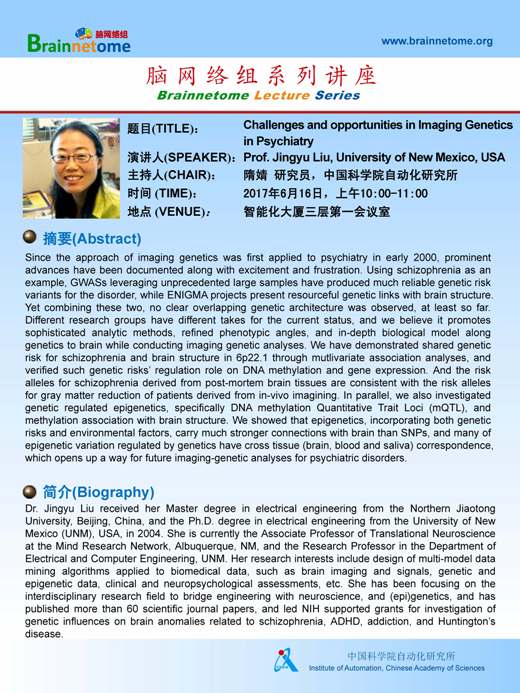Title: Challenges and opportunities in Imaging Genetics in Psychiatry
Speaker: Prof. Jingyu Liu, University of New Mexico, USA
Chair: Prof. Jing Sui, Brainnetome Center, CASIA
Time: 10:00-11:00, June. 16, 2017
Venue: The 1st meeting room, 3rd floor of the Intelligence Building
[Abstract]
Since the approach of imaging genetics was first applied to psychiatry in early 2000, prominent advances have been documented along with excitement and frustration. Using schizophrenia as an example, GWASs leveraging unprecedented large samples have produced much reliable genetic risk variants for the disorder, while ENIGMA projects present resourceful genetic links with brain structure. Yet combining these two, no clear overlapping genetic architecture was observed, at least so far. Different research groups have different takes for the current status, and we believe it promotes sophisticated analytic methods, refined phenotypic angles, and in-depth biological model along genetics to brain while conducting imaging genetic analyses. We have demonstrated shared genetic risk for schizophrenia and brain structure in 6p22.1 through mutlivariate association analyses, and verified such genetic risks' regulation role on DNA methylation and gene expression. And the risk alleles for schizophrenia derived from post-mortem brain tissues are consistent with the risk alleles for gray matter reduction of patients derived from in-vivo imagining. In parallel, we also investigated genetic regulated epigenetics, specifically DNA methylation Quantitative Trait Loci (mQTL), and methylation association with brain structure. We showed that epigenetics, incorporating both genetic risks and environmental factors, carry much stronger connections with brain than SNPs, and many of epigenetic variation regulated by genetics have cross tissue (brain, blood and saliva) correspondence, which opens up a way for future imaging-genetic analyses for psychiatric disorders.
[Biography]
Dr. Jingyu Liu received her Master degree in electrical engineering from the Northern Jiaotong University, Beijing, China, and the Ph.D. degree in electrical engineering from the University of New Mexico (UNM), USA, in 2004. She is currently the Associate Professor of Translational Neuroscience at the Mind Research Network, Albuquerque, NM, and the Research Professor in the Department of Electrical and Computer Engineering, UNM. Her research interests include design of multi-model data mining algorithms applied to biomedical data, such as brain imaging and signals, genetic and epigenetic data, clinical and neuropsychological assessments, etc. She has been focusing on the interdisciplinary research field to bridge engineering with neuroscience, and (epi)genetics, and has published more than 60 scientific journal papers, and led NIH supported grants for investigation of genetic influences on brain anomalies related to schizophrenia, ADHD, addiction, and Huntington's disease.
